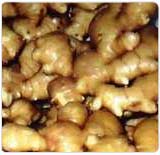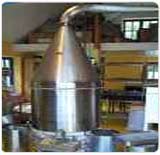 Ask for Price  Ask for Price |
Ginger is a perennial herb and grows to about 3 - 4 feet high with a thick spreading tuberous rhizome. Every year it shoots up a stalk with narrow spear-shaped leaves, as well as white or yellow flowers growing directly from the root. Ginger oil is steam distilled from the root of Zingiber officinale. It has a fresh, warm, woody, sweet bright top note and is pale yellow to dark amber in colour. The essential oil has various chemical constituents including the following: a-pinene, camphene, b-pinene, 1,8-cineole, linalool, borneol, y-terpineol, nerol, neral, geraniol, geranial, geranyl acetate, b-bisabolene and zingiberene.
Medicinally it has been used for ailments of the digestive system, for arthritis, bronchitis, bruises, chills, colds, colic, congestion, constipation, coughs, cramps, diarrhea, fatigue, fever, flatulence, flu, hangover, headaches, indigestion, loss of appetite, muscular aches and pains, nausea, nervous exhaustion, poor circulation, rheumatism, sinusitis, sore throat, sprains, toothache, travel and sea sickness, varicose veins, for catarrhal lung conditions, for bruises on the skin, to boost the heart, to help with mucus and phlegm, for fractures, carbuncles, hangovers, for motion sickness, morning sickness. Its warming qualities are good to use for feelings of loneliness and winter depression, and its energizing properties make it a good aphrodisiac. It helps to relieve spasms, aches and ease stiffness in joints.
It also has a history in the perfume industry, and is considered to have an oriental note to it. Ginger oil is widely used in the food industry. It may be added to a blend to be diffused into the air, or to a carrier oil and rubbed on the earlobes, temples, or base of the neck. It is used in burners and vaporizers, in bath, blended in base cream, and in hot compress.
It is analgesic, antibacterial, anticoagulant, anti-inflammatory, antioxidant, antiseptic, antispasmodic, aperitive, aphrodisiac, astringent, carminative, cephalic, cholagogue, diaphoretic, digestive, diuretic, expectorant, febrifuge, laxative, rubefacient, stimulant, stomachic, tonic, vasodilator, anti-emetic and sudorific.
Ginger oil blends well with Bergamot, Cedarwood, Clove, Coriander, Eucalyptus, Frankincense, Geranium, Grapefruit, Jasmine, Juniper, Lemon, Lime, Mandarin, Neroli, Orange, Palmarosa, Patchouli, Rose, Sandalwood, Vetiver and Ylang ylang oils.
Ginger oil blends well with Bergamot, Cedarwood, Clove, Coriander, Eucalyptus, Frankincense, Geranium, Grapefruit, Jasmine, Juniper, Lemon, Lime, Mandarin, Neroli, Orange, Palmarosa, Patchouli, Rose, Sandalwood, Vetiver and Ylang ylang oils.
Specifications of Indian Ginger oil

